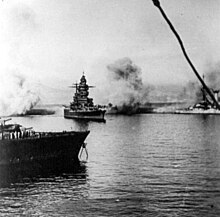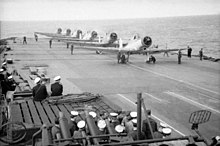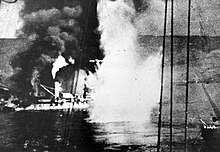Operation Catapult
The operation Catapult was a company of the Royal Navy of Great Britain on July 3, 1940 during the Second World War against the majority of the port of Mers-el-Kebir lying fleet of former allies France . Previously, the common defensive battle against the German invasion of France , which led to the French surrender on June 22nd ( Compiègne armistice ), had failed. The fleet was to be largely switched off in order to prevent the Vichy regime from handing over the ships to Germany . The operation began early in the morning along with Operation Grasp , which saw the capture and confiscation of all French ships in British waters. About 1,300 French sailors died in the British attack. As a result, the Vichy government broke off diplomatic relations with Great Britain.
prehistory
With the capitulation of France on June 22, 1940, Great Britain lost its most important ally to Germany. The surrender conditions for France provided for an independent government and administration , which should also keep control of the French fleet. Most of the naval units had already sailed into the Mediterranean before the surrender and were lying there in foreign ports. The bulk of the fleet was in Mers-el-Kébir near Oran , France's naval port in Algeria . British Prime Minister Winston Churchill did not trust the Vichy government's pledges to prevent the Germans from accessing the ships. For Great Britain there was a risk that the French fleet could be used on the Axis side against the Royal Navy. So he decided to strike against these groups of ships.
The British Admiralty reported to its political leadership on June 27th that a fleet could be brought into position in front of Mers-el-Kébir by July 3rd. This Force H under the command of Vice Admiral James Fownes Somerville consisted of the aircraft carrier HMS Ark Royal , the battle cruiser HMS Hood , the battleships HMS Valiant , HMS Resolution and HMS Nelson as well as other cruisers and destroyers.
On July 3rd, a British naval formation appeared in front of Oran and surprised the non-combat-ready French fleet. The British gave the French admiral Marcel Gensoul an ultimatum on Churchill's orders with several options, on the one hand that he could enter British ports with his ships and crews, from where he and his men would be returned to France. As an alternative, a transfer to distant French ports, such as Martinique , was proposed. There the ships were to be disarmed under British control. It was also suggested that he defected immediately and that he could fight the Germans and Italians with his ships together with the British. In addition, a return of the ships to France was promised after the end of the war. As a last option it was proposed to sink the ships themselves. Should the French not be able to choose one of the options, the British naval association threatened them with immediate destruction.
The ultimatum
In addition to the older battleships Provence and Bretagne , the most modern battleships Dunkerque and Strasbourg as well as the seaplane carrier Commandant Teste and six destroyers were located in the port . The commander of "Force H", Admiral James Somerville, stationed in Gibraltar, was ordered to deliver the ultimatum.
“It is impossible for us, your comrades up to now, to allow your fine ships to fall into the power of the German enemy. We are determined to fight on until the end, and if we win, as we think we shall, we shall never forget that France was our Ally, that our interests are the same as hers, and that our common enemy is Germany. Should we conquer we solemnly declare that we shall restore the greatness and territory of France. For this purpose we must make sure that the best ships of the French Navy are not used against us by the common foe. In these circumstances, His Majesty's Government have instructed me to demand that the French Fleet now at Mers el Kebir and Oran shall act in accordance with one of the following alternatives;
- (a) Sail with us and continue the fight until victory against the Germans.
- (b) Sail with reduced crews under our control to a British port. The reduced crews would be repatriated at the earliest moment. If either of these courses is adopted by you we will restore your ships to France at the conclusion of the war or pay full compensation if they are damaged meanwhile.
- (c) Alternatively if you feel bound to stipulate that your ships should not be used against the Germans unless they break the Armistice, then sail them with us with reduced crews to some French port in the West Indies - Martinique for instance - where they can be demilitarized to our satisfaction, or perhaps be entrusted to the United States and remain safe until the end of the war, the crews being repatriated.
If you refuse these fair offers, I must with profound regret, require you to sink your ships within 6 hours. Finally, failing the above, I have the orders from His Majesty's Government to use whatever force may be necessary to prevent your ships from falling into German hands. "
“It is impossible for us, who are your comrades to this day, to allow your excellent ships to fall into the hands of the German enemy. We are determined to fight to the end and if, as we believe, we win, we will never forget that France was our ally, that we have the same goals and that our common enemy is Germany. We solemnly declare that if we win, we will restore the greatness and territory of France. To that end, we must ensure that the best ships in the French fleet cannot be used against us by the common enemy. In these circumstances, His Majesty's Government has instructed me to require the French fleet at Mers el Kebir and Oran to act on one of the following alternatives:
- a) To ride with us and continue the fight against Germany until victory.
- b) To sail to a UK port with a reduced crew under our control. The reduced crew would be returned home at the earliest possible time. If you accept one of these options, we will return your ships to France at the end of the war or pay full compensation if they are damaged in the meantime.
- c) Alternatively, if you feel obliged to stipulate that your ships should not be used against the Germans, unless they break the armistice, then take them with us under reduced crew to a French port in the West Indies - for example Martinique - where they can be demilitarized to our satisfaction or, if necessary, entrusted to the United States and are safe until the end of the war while the crews are returned home.
Should you refuse these fair offers, I have to demand with deep regret that you sink your ships within 6 hours. In the end, should the above not be followed, I have received orders from His Majesty's government to use whatever force is necessary to prevent your ships from falling into German hands. "
It was not Admiral James Somerville who gave the ultimatum, but rather the better French-speaking Captain Cedric Holland, a commanding officer of HMS Ark Royal . Admiral Gensoul, offended that the news was not delivered by an officer of his own rank, sent Lieutenant Bernard Dufay to take the news, causing delay and confusion.
Before the negotiations were concluded, Swordfish fighter jets of the carrier Ark Royal , escorted by Skuas , began to mine the port entrance. As a first combat operation, French P-36 fighters tried to prevent this. A Skua was shot down. Their occupation was the only British loss in this operation.
The attack
The operation Catapult began in the early morning of July 3, 1940, together with the operation Grasp , were captured in all UK waters located French ships and confiscated. The Force H with the Hood as its flagship headed for the port of Mers-El-Kébir and sent the French a final ultimatum shortly after midnight. After no response was received, the ultimatum was extended by one point: the French were asked to sink their ships on the spot. To underline the ultimatum, planes took off from the Ark Royal at around 1 a.m. to mine the port entrance. This alarmed the French; until then they had taken the British threats as a bluff. But again they did not reply to the ultimatum. At 4:46 p.m. Somerville received the message that he now had a free hand as French reinforcements were on the way. Churchill ordered fire on the French ships.
After the ultimatum had expired, the Hood opened fire with its heavy artillery at 16:56 on the battleship Bretagne , which capsized, sank and dragged 977 sailors with it into the depths within a few minutes. The British ships kept firing for about a quarter of an hour. Then the battleships Dunkerque and Provence were put out of action and were steered into shallow water to prevent sinking. The destroyer Mogador was badly damaged and was also set aground. All three ships were salvaged and repaired soon after the attack. Somerville ordered a ceasefire and asked the French again to sink their ships themselves. So that they did not remain within range of the French coastal guns and ships, he simultaneously withdrew his force from the port. The battleship Strasbourg took advantage of this opportunity and escaped together with six destroyers through the mined port exit. Chase by the Hood and Ark Royal planes was unsuccessful. The ship managed to escape to Toulon .
The only larger French ship that survived the bombardment with virtually no damage was the Commandant Teste . She escaped from the mined port during the night and ran via Arzew first to Bizerta and then to Toulon. The ship was sighted by a British submarine, but it found no opportunity to attack.
The Dunkerque was attacked three days later by torpedo bombers from the Ark Royal . A torpedo hit the auxiliary ship anchored next to the battleship, another detonated its depth charge. The side of the ship below tower “B” of the battleship was torn open over a large area by this explosion. The Dunkerque made the water strong and sank to the shallow harbor floor. There were further losses of 154 dead and wounded.
Units involved
- Hood - battle cruiser
- Resolution - battleship
- Valiant - battleship
- Ark Royal - aircraft carrier (with 24 Skuas and 30 Swordfish )
- Arethusa - light cruiser
- Enterprise - light cruiser
- Active - destroyer
- Escort destroyer
- Faulknor - destroyer
- Fearless - destroyer
- Foresight - destroyer
- Forester - destroyer
- Foxhound - destroyer
- Keppel - destroyer
- Vidette - destroyer
- Vortigern - destroyer
- Wrestler - destroyer
French Navy
- Dunkerque - battleship
- Strasbourg - battleship
- Brittany - battleship
- Provence - battleship
- Commandant Teste - seaplane carrier
- Kersaint - destroyer
- Lynx - destroyer
- Mogador - destroyer
- La Terrible - destroyer
- Tigre - destroyer
- Volta - destroyer
Alexandria
In Alexandria , the base of the British Mediterranean Fleet, Admiral Andrew Browne Cunningham reached an agreement with the commander of the French Force X , Vice Admiral René-Emile Godfroy . The French ships lying there were disarmed and immobilized in the presence of the British.
Result
The attack severely damaged the relationship between France and Great Britain and strengthened the support of the Vichy regime in the French army.
In the attack in Mers-el-Kébir, depending on the source, between 1147 and approx. 1300 French seamen died and 351 to approx. 400 were wounded. Six British planes were shot down by French anti-aircraft guns. The French bombed Gibraltar in retaliation on September 24th and 25th, 1940 , but caused only minor damage.
When the Wehrmacht in November 1942 the rest of France occupied , is sunk the French fleet in the port of Toulon itself.
See also
literature
- Bertrand M. Gordon: Historical Dictionary of World War II France - the Occupation, Vichy and the Resistance, 1938-1946. Greenwood Press, Westport Connecticut 1998, ISBN 978-0-313-29421-1 . Lemma Mers-el-Kébir , p. 242 f.
Web links
- Documents of the British Admiralty to Operation Catapult (English)
- Information on the homepage of the Jewish Virtual Library (English)
- detailed information on a private homepage (English)
- Information about Operation Catapult on a private homepage (English)
Individual evidence
- ^ John D. Grainger: Traditional Enemies: Britain's War With Vichy France 1940–1942, Barnsley, 2013, p. 28, ISBN 978-1-78159-154-3 .
- ^ Gordon, B .: Historical Dictionary of World War Two France: The Occupation, Vichy and the Resistance, 1938-1946 (Westport, Conn., 1998), pp. 242f.
- ^ John Jordan: The aircraft transport Commandant Teste. In: Warship 2002-2003. Conway's Maritime Press, ISBN 0-85177-926-3 (English).
- ↑ Vincent P. O'Hara: Struggle for the Middle Sea. The great Navies at War in the Mediterranean Theater, 1940-1945. US Naval Institute Press, Annapolis MD 2009, ISBN 978-1-59114-648-3 .





